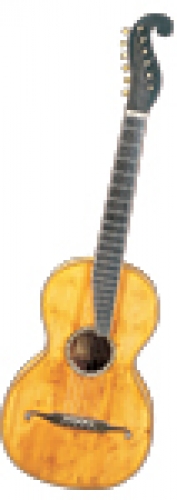C. F. Martin and His Guitars: 1796-1873. By Philip F. Gura. University of North Carolina Press, 352 pages, $45.
He fashioned each instrument with care. With rosewood or mahogany, he handcrafted the body and neck. He used spruce for the sounding board, ebony for the fingerboard, and applied trim and accents of maple or holly. He added tuning pegs of metal or bone, six strings, and ivory or shell ornamentation. Finally, Christian Frederick Martin labeled the guitar with its most valuable feature — his name.
“He was considered the premier American maker,” says Philip Gura, professor of American literature and culture. “Even in his lifetime, a Martin was called ‘America’s guitar.’”
Martin’s reputation thrived in spite of his refusal to buy into the mass production done by many of his contemporaries. “I think it was the basic care he gave to the construction of the instruments that made them so well known,” Gura says.
And of course, though today’s Martin guitars are styled differently from the nineteenth-century “parlor guitars” made by C.F. Martin himself, they are still considered among the finest acoustic guitars one can buy. The very fame of the instruments made by C. F. Martin & Company has made the original Martin, founder of the company, rather legendary — though most people knew very little about the man himself.
Philip Gura has changed that with his new book, C.F. Martin and His Guitars, 1796-1873. Gura embarked on the project when he discovered scores of nineteenth-century account books and letters at the Martin factory in Nazareth, Pennsylvania. It’s unusual for a company to have such a rich archive of materials from the 1800s, Gura says. The Martin Company allowed Gura to borrow the valuable materials, which he deposited in Carolina’s Wilson Library as he worked with them, teasing out the story he wanted to tell.
C. F. Martin’s story begins in Germany, where he, like his father, apprenticed as a craftsman in the European guild system. Perhaps seeking new opportunities to pursue guitar making, Martin immigrated to New York City with his own family in 1835. Martin was at first a music wholesaler, selling and repairing instruments as well as making his own guitars. When he relocated to Nazareth, Pennsylvania, in 1839, Martin began to answer his true calling in earnest, Gura believes.
By the 1850s, Martin was solely a guitar maker, and one whose work was highly prized. People attempted forgeries of Martin’s guitars even in his lifetime, Gura found. He also found letters to Martin from many people anxious to become his agent in the critical New York guitar market. By the time of his death in 1873, Martin was firmly established as a master, and the lasting success and family legacy of the company were ensured by his partnership with his son.
Gura’s book is more than a biography of C. F. Martin. The story of Martin’s life is a window into the music business, and business generally, in the nineteenth century, Gura says.
“What I really tried to do was to show how a person who had a skill, a certain kind of craft, was energized and pushed into a different kind of market here in America and learned how to negotiate it, how to use it for his own career,” he says. “And you can just substitute some other goods — hats, or some kinds of machine — and they would’ve had to have been distributed and dealt with among customers in a very similar way.”
The musical culture of the nineteenth century is not unfamiliar territory for Gura. In fact, the cultural and social history of that century is one of his specialties. Gura’s new book elaborates in some ways upon the story he told in his 1999 award-winning book, America’s Instrument: The Banjo in the Nineteenth Century.
While Gura’s earlier book sought to elevate the common banjo to its place in the pantheon of American music, however, his new work does rather the opposite — it makes the godlike Martin human. “We knew almost nothing about him, and now we have all the contours of his life in a very new way,” Gura says. “I’m really proud of that fact, and I think Martin’s descendants are very happy with that result, too.”
Today, the Martin Company has mechanized production to a degree necessitated by a modern economy, but the instruments the company produces are as fine as ever, and still ultimately handcrafted, Gura says. Inside a huge factory staffed by hundreds of employees, vast machines cut materials to the dimensions of the great Martin guitars used as models. Once the pieces of a guitar are “roughed out,” an employee puts the instrument together and finishes it by hand, down to the most intricate inlay work. The entire production is overseen by C.F. Martin IV.
“I like to think about C.F. Martin the Fourth as doing what his predecessors did,” Gura says. “He continues to insist that the finished product is labored over by people with their hands, and I think that’s part of the continuing legend of the company.”
Michelle Coppedge was formerly a staff writer for Endeavors.


